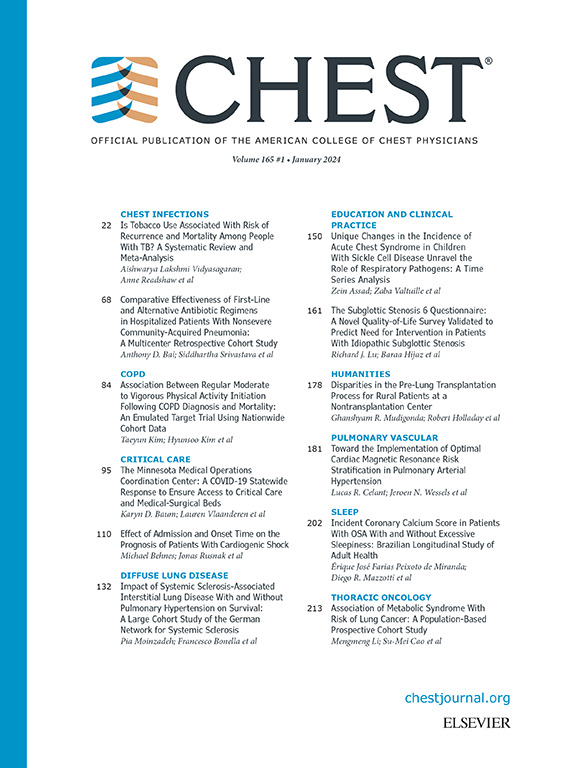COVID-19对肺部重症监护人员在职考试成绩的影响:一项全国性研究
IF 9.5
1区 医学
Q1 CRITICAL CARE MEDICINE
引用次数: 0
摘要
2020年至2022年期间,COVID-19大流行扰乱了卫生和教育。许多培训机构修改了学员的轮转,减少了门诊,同时增加了住院和ICU时间。了解大流行对医疗学员认知表现的影响,对于在危机期间通报战略和支持学员的福祉至关重要。研究问题:COVID-19大流行对肺与重症监护医学(PCCM)研究员在培训考试(ITE)中的表现有什么影响?研究设计和方法回顾性研究包括2015年4月至2022年7月期间完成PCCM- ite的所有美国PCCM患者。参与者被分为三组。大流行前(PP)(2020年3月1日之前的ITE)、第一波COVID (CW1)(2020年3月1日至2021年6月30日)和第二波CW (CW2)(2021年7月1日当日或之后)。我们使用线性混合效应模型来探索流行病与ITE评分之间的关系。结果共评估了8391名个体的12774份PCCM-ITE考试成绩。在CW1期间,FY0和FY1的LS平均总分与PP相似。然而,FY2和FY3表现出更高的LS平均总分,与PP相比分别差异2.0% (95% CI 0.4%-3.5%, p=0.02)和2.9% (95% CI 1.3%-4.6%, p=0.001)。FY3学员在CW1期间的LS平均肺分评分高5.3% (95% CI 1.5%-9.1%, p=0.01),而在CW1或CW2期间,其他学员水平的LS平均评分无显著差异。在所有时间段内,FY1、FY2和FY3受训者的重症监护分项得分相似。与pp相比,FY0学员在CW1 (-2.2%, 95% CI -4.3%- 0.1%, p=0.04)和CW2 (-2.9%, 95% CI -4.9%- 0.8%, p=0.007)期间的重症监护评分较低。结论:流行病对认知表现的影响很小,可能被CW1期间学员自我学习机会的增加所缓冲。本文章由计算机程序翻译,如有差异,请以英文原文为准。
Impact of COVID-19 on Pulmonary Critical Care Fellows In-Training Exam Performance: A National Study.
BACKGROUND
Between 2020 and 2022, the COVID-19 pandemic disrupted health and education. Many training institutions modified trainees' rotations, decreasing outpatient clinics while increasing inpatient and ICU time. Understanding pandemic's impact on medical trainees' cognitive performance is essential for informing strategies and supporting trainee well-being during crises.
RESEARCH QUESTION
What was the impact of the COVID-19 pandemic on the performance of Pulmonary and Critical Care Medicine (PCCM) fellows on the in-training examination (ITE)?
STUDY DESIGN AND METHODS
Retrospective study included all PCCM fellows in US who completed the PCCM-ITE between April 2015 and July 2022. Participants were divided into three cohorts. Pre-pandemic (PP) (ITE before March 1, 2020), a 1st COVID wave (CW1) (March 1, 2020 - June 30, 2021), and 2nd CW cohorts (CW2) (on or after July 1, 2021). We used a linear mixed effect model to explore the relationship between the pandemic and ITE scores.
RESULTS
A total of 12,774 PCCM-ITE exam scores were evaluated for 8391 individuals. During CW1, LS mean total scores for FY0 and FY1 were similar to those in the PP. However, FY2 and FY3 demonstrated higher LS mean total scores, with differences of 2.0% (95% CI 0.4%-3.5%, p=0.02) and 2.9% (95% CI 1.3%-4.6%, p=0.001), respectively, compared to the PP. LS mean pulmonary subsection scores were 5.3% (95% CI 1.5%-9.1%, p=0.01) higher for FY3 trainees during CW1 while no significant differences were observed for other trainee levels during CW1 or CW2. Critical care subsection scores were similar for FY1, FY2, and FY3 trainees across all time periods. FY0 trainees had lower critical care scores during CW1 (-2.2%, 95% CI -4.3%--0.1%, p=0.04) and CW2 (-2.9%, 95% CI -4.9%--0.8%, p=0.007), compared to PP.
INTERPRETATION
In conclusion, pandemic impacts on cognitive performance were minimal, possibly buffered by enhanced self-study opportunities among trainees during CW1.
求助全文
通过发布文献求助,成功后即可免费获取论文全文。
去求助
来源期刊

Chest
医学-呼吸系统
CiteScore
13.70
自引率
3.10%
发文量
3369
审稿时长
15 days
期刊介绍:
At CHEST, our mission is to revolutionize patient care through the collaboration of multidisciplinary clinicians in the fields of pulmonary, critical care, and sleep medicine. We achieve this by publishing cutting-edge clinical research that addresses current challenges and brings forth future advancements. To enhance understanding in a rapidly evolving field, CHEST also features review articles, commentaries, and facilitates discussions on emerging controversies. We place great emphasis on scientific rigor, employing a rigorous peer review process, and ensuring all accepted content is published online within two weeks.
 求助内容:
求助内容: 应助结果提醒方式:
应助结果提醒方式:


